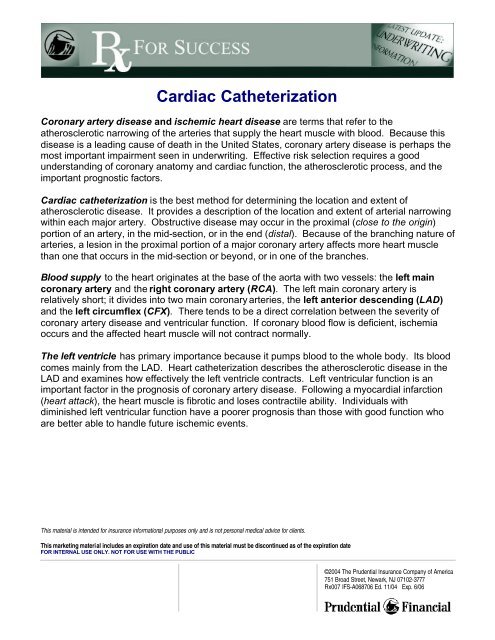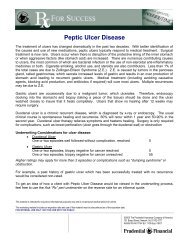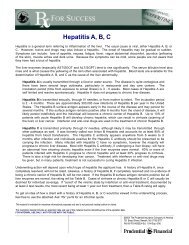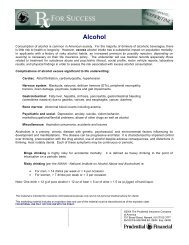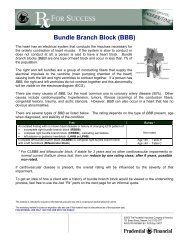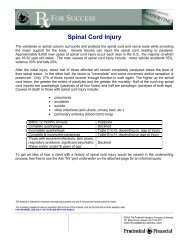Cardiac Catheterization - BSI / Home
Cardiac Catheterization - BSI / Home
Cardiac Catheterization - BSI / Home
Create successful ePaper yourself
Turn your PDF publications into a flip-book with our unique Google optimized e-Paper software.
<strong>Cardiac</strong> <strong>Catheterization</strong><br />
Coronary artery disease and ischemic heart disease are terms that refer to the<br />
atherosclerotic narrowing of the arteries that supply the heart muscle with blood. Because this<br />
disease is a leading cause of death in the United States, coronary artery disease is perhaps the<br />
most important impairment seen in underwriting. Effective risk selection requires a good<br />
understanding of coronary anatomy and cardiac function, the atherosclerotic process, and the<br />
important prognostic factors.<br />
<strong>Cardiac</strong> catheterization is the best method for determining the location and extent of<br />
atherosclerotic disease. It provides a description of the location and extent of arterial narrowing<br />
within each major artery. Obstructive disease may occur in the proximal (close to the origin)<br />
portion of an artery, in the mid-section, or in the end (distal). Because of the branching nature of<br />
arteries, a lesion in the proximal portion of a major coronary artery affects more heart muscle<br />
than one that occurs in the mid-section or beyond, or in one of the branches.<br />
Blood supply to the heart originates at the base of the aorta with two vessels: the left main<br />
coronary artery and the right coronary artery (RCA). The left main coronary artery is<br />
relatively short; it divides into two main coronary arteries, the left anterior descending (LAD)<br />
and the left circumflex (CFX). There tends to be a direct correlation between the severity of<br />
coronary artery disease and ventricular function. If coronary blood flow is deficient, ischemia<br />
occurs and the affected heart muscle will not contract normally.<br />
The left ventricle has primary importance because it pumps blood to the whole body. Its blood<br />
comes mainly from the LAD. Heart catheterization describes the atherosclerotic disease in the<br />
LAD and examines how effectively the left ventricle contracts. Left ventricular function is an<br />
important factor in the prognosis of coronary artery disease. Following a myocardial infarction<br />
(heart attack), the heart muscle is fibrotic and loses contractile ability. Individuals with<br />
diminished left ventricular function have a poorer prognosis than those with good function who<br />
are better able to handle future ischemic events.<br />
This material is intended for insurance informational purposes only and is not personal medical advice for clients.<br />
This marketing material includes an expiration date and use of this material must be discontinued as of the expiration date<br />
FOR INTERNAL USE ONLY. NOT FOR USE WITH THE PUBLIC<br />
©2004 The Prudential Insurance Company of America<br />
751 Broad Street, Newark, NJ 07102-3777<br />
Rx007 IFS-A068706 Ed. 11/04 Exp. 6/06
Left ventricular function is commonly expressed in three ways:<br />
(1) EJECTION FRACTION (EF) is the best measure of left ventricular function. When the left<br />
ventricular walls contract, blood is ejected into the aorta and throughout the body. The<br />
amount of blood that is ejected is called the Ejection Fraction and 55% or greater is<br />
normal. EF below 50% usually indicates some degree of left ventricular dysfunction. The<br />
lower the percentage, the worse the function and prognosis. EF below 40% is unfavorable.<br />
(2) THE WALL MOTION of the left ventricle can be observed during ventricular contraction. Areas<br />
of ischemia and infarction may not contract appropriately. If an area moves to a lesser<br />
extent than expected, it is called hypokinetic. When there is no motion, it is described as<br />
akinetic. If a portion of the left ventricular wall bulges outward during contraction, it is<br />
called dyskinetic. Sometimes the entire wall of the left ventricle moves sluggishly. This is<br />
called generalized, diffuse, or global hypokinesis. It is not uncommon to have several<br />
areas of the left ventricular wall affected. Some may be hypokinetic while others may be<br />
dyskinetic or akinetic.<br />
(3) LEFT VENTRICULAR END-DIASTOLIC PRESSURE (LVEDP) is another measure of function. If the<br />
left ventricle is impaired and unable to propel blood into the aorta with adequate force,<br />
excess blood volume remains in the ventricle. This leads to elevation of filling pressures<br />
within the left ventricle. Normal left ventricular filling pressure is 8-12 mmHG. An elevated<br />
LVEDP is an indication that left ventricular function is impaired.<br />
To get an idea of how a client with a history of cardiac catheterization would be viewed in the<br />
underwriting process, please feel free to use the attached Ask “Rx” pert underwriter for an<br />
informal quote.<br />
This material is intended for insurance informational purposes only and is not personal medical advice for clients.<br />
This marketing material includes an expiration date and use of this material must be discontinued as of the expiration date<br />
FOR INTERNAL USE ONLY. NOT FOR USE WITH THE PUBLIC<br />
©2004 The Prudential Insurance Company of America<br />
751 Broad Street, Newark, NJ 07102-3777<br />
Rx007 IFS-A068706 Ed. 11/04 Exp. 6/06
<strong>Cardiac</strong> <strong>Catheterization</strong> – Ask “Rx” pert underwriter<br />
(ask our experts)<br />
Producer _______________________ Phone __________________ FAX _______________<br />
Client __________________________ Age/DOB _______________ Sex ________________<br />
If your client has had a cardiac catheterization, please answer the following:<br />
Please list date(s) of any catheterization(s): _________________________________<br />
‚ Has your client had any of the following:<br />
q heart attack ____________ (date)<br />
q bypass surgery ____________ (date)<br />
q angioplasty ____________ (date)<br />
ƒ<br />
Is your client on any medications<br />
q yes, please give details _______________________________________<br />
q no<br />
„ Please check if your client has had any of the following:<br />
q history of chest pain<br />
q diabetes<br />
q lipid disorder<br />
q family history of heart disease<br />
q overweight<br />
q high blood pressure<br />
…<br />
Has your client smoked cigarettes in the last 12 months<br />
q yes<br />
q no<br />
† Does your client have any other major health problems (ex: cancer, etc.)<br />
q yes, please give details _______________________________________<br />
q no<br />
Please submit a copy of the cardiac catheterization report(s).<br />
After reading the Rx for Success on <strong>Cardiac</strong> <strong>Catheterization</strong>, please feel free to use this Ask “Rx” pert underwriter<br />
for an informal quote.<br />
This material is intended for insurance informational purposes only and is not personal medical advice for clients.<br />
This marketing material includes an expiration date and use of this material must be discontinued as of the expiration date<br />
FOR INTERNAL USE ONLY. NOT FOR USE WITH THE PUBLIC<br />
©2004 The Prudential Insurance Company of America<br />
751 Broad Street, Newark, NJ 07102-3777<br />
Rx007 IFS-A068706 Ed. 11/04 Exp. 6/06


